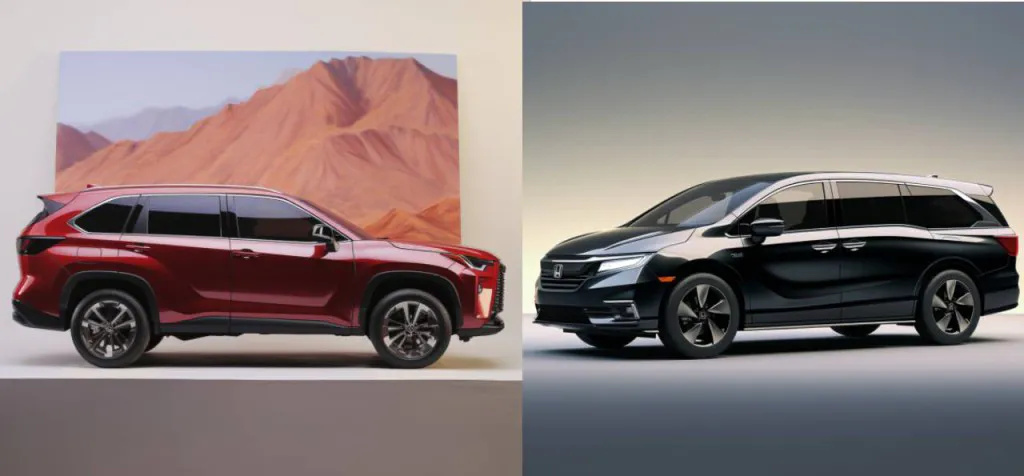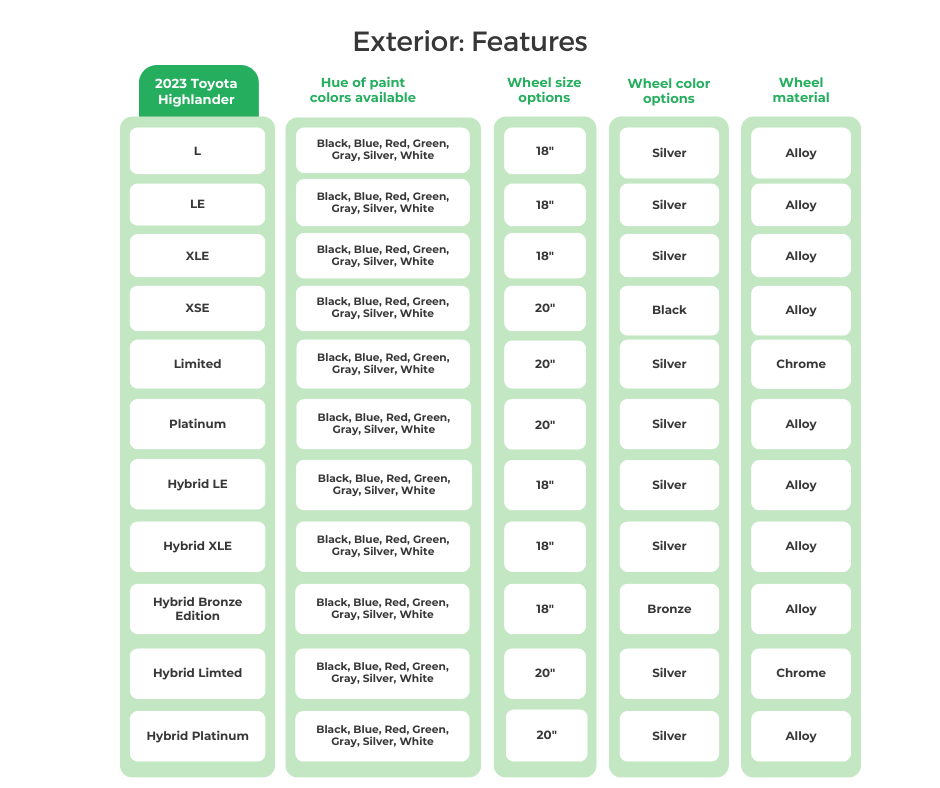The SUV versus minivan debate is never-ending, as each body style has fans and critics. While some buyers may already have set opinions, others may be more open-minded about which vehicle best meets their needs. Hence, the reason for comparing the 2023 Toyota Highlander and the 2023 Honda Odyssey. Both models represent leaders in their respective classes, although the minivan segment isn’t very crowded (the Odyssey competes against the Toyota Sienna, Chrysler Pacifica, and Kia Carnival).
The Highlander is among Toyota’s best-sellers, only eclipsed by the RAV4, Camry, and Corolla. What it lacks in charisma is made up for by immense practicality. The Odyssey is in the same boat. No one ever said, “Look at that cool Odyssey.” They’re more likely to remark, “I can put so many people and a lot of stuff in there.”
I can recall two occasions when I seriously considered buying an Odyssey. It was relatively responsive to drive, offered very comfortable accommodations, and could swallow just about anything I might need to carry. Ultimately, I went the SUV route (a different Honda product). But not because of any stigma associated with driving a minivan; it simply was too big for my needs.
My experiences sum up the Highlander versus Odyssey challenge in two questions. How much space do you need? And how much are you willing to pay for this capacity?
Of course, there are other considerations. If all-wheel drive is a must-have, you can cross the front-wheel-drive Odyssey off your list. In addition, if you regularly transport more than five people, the Highlander and its tight third row may not be the best choice.
One of the most significant takeaways from this comparison is that the Odyssey’s abundant space doesn’t come at a premium over the Highlander. Except for the top-tier Elite trim, the Honda is $1,100 to $1,800 less than a similarly equipped Highlander. In essence, you’re paying a surcharge to join the SUV club. So, someone more focused on finances than the image can save some coin upfront by selecting an Odyssey.
But, and there’s always a “but,” the Highlander is slightly cheaper to own over time (covered in detail later). However, the extra penny per mile of ownership costs for the Odyssey is modest, considering these vehicles cost $40,000-$50,000.
Another cost to consider is fuel economy (detailed below). The Odyssey’s combined mpg of 25 isn’t shameful for such a large vehicle. Yet, it can’t hold a candle to the combined 36 mpg the Highlander Hybrid offers. This 40% fuel economy bump can lead to substantial savings over the years.
Continue reading for a complete look at what separates the 2023 Highlander and Odyssey. You’ll learn the details covering prices, powertrains, ownership expenses, safety testing, cabin size, features, and safety tech.
Curious about how older Highlander and Odyssey models stack up? Read: Toyota Highlander vs. Honda Odyssey | The Best Model Year For Every Budget.
Learn more about the methodology used for this article.
2023 Toyota Highlander vs. Honda Odyssey | A Guide to Trim Levels & Optional Features
Trim Levels: Starting Prices
Quick Take: The Odyssey has a lower MSRP, except for the top trim.
A simple look at the bottom line shows that the cheapest Highlander (the L with an MSRP of $36,620) is less expensive than the base Odyssey (the EX at $37,840). However, this isn’t an even comparison. After 2022, Honda axed the Odyssey LX, the model’s most affordable trim. Honda moved its minivan upscale, making the EX the starting point. So, a more accurate comparison matches the Highlander LE ($39,020) against the Odyssey EX, which results in a $1,180 premium for the Toyota. This also reflects the Highlander LE having front-wheel drive, like the Odyssey.
Moving upscale—the Highlander XLE at $42,020 and the Odyssey EX-L at $40,918—reinforces the Honda’s price advantage. Not only is this minivan $1,102 cheaper, but it comes with leather upholstery versus leatherette in the Toyota.
Meanwhile, both automakers offer sporty versions, which are appearance upgrades (black-finish exterior trim and wheels): the Highlander XSE ($43,615) and Odyssey Sport ($41,860). Again, the Odyssey’s price advantage (almost $1,800) continues.
Shopping for a model that’s almost at the top of the range shows the Odyssey is still cheaper, but the difference narrows to $1,175. The Highlander Limited has a $46,275 window sticker compared to $45,100 for the Odyssey Touring. Here, the Highlander finally gets leather seating and adds heated and ventilated front seats (these front-row extras only come with the top-dog Odyssey Elite). However, the Odyssey Touring has numerous high-tech goodies, like a rear-seat entertainment system and a cabin intercom.
The price factor reverses (modestly) when looking at the top of each model’s range. The Highlander Platinum’s $49,475 starting price is $495 less than the Odyssey Elite’s $49,970. Chances are, a 1% difference in price isn’t going to persuade many buyers, but some shoppers are chiefly focused on the bottom line.
Adding all-wheel drive to the Highlander only makes the above prices higher.
I’ll mention the Highlander Hybrid because Toyota charges a quite reasonable $1,600 extra for a 20%-60% improvement in fuel economy (covered later in this article). The Odyssey relies on conventional gasoline power.
| 2023 Toyota Highlander Model | Starting Price |
| L | $36,620 |
| LE | $39,020 |
| XLE | $42,020 |
| XSE | $43,615 |
| Limited | $46,275 |
| Platinum | $49,475 |
| Hybrid LE | $40,620 |
| Hybrid XLE | $43,620 |
| Hybrid Bronze Edition | $46,380 |
| Hybrid Limited | $47,875 |
| Hybrid Platinum | $51,075 |
| 2023 Honda Odyssey Model | Starting Price |
| EX | $37,840 |
| EX-L | $40,918 |
| Sport | $41,860 |
| Touring | $45,100 |
| Elite | $49,970 |
Cost of Ownership
Quick Take: The Highlander is slightly cheaper to own over the long term than the Odyssey.
Wise car shoppers also consider long-term ownership costs before signing a deal. A deal at the dealership could lead to unpleasant surprises later on.
However, this isn’t an issue in the Highlander versus Odyssey realm. Edmunds estimates that owners of a 2023 Highlander LE will pay $0.69 per mile over five years compared to $0.70 for owners of a 2023 Odyssey EX—a difference of $780 over five years, based on 15,000 miles per year.
The Highlander’s lower depreciation and reduced fuel use are partially offset by the Odyssey’s cheaper maintenance requirements and lower starting price. Nonetheless, the Highlander is still cheaper to own, even if by a very modest amount.
| 5-Year Ownership Cost | ||
| Costs | Toyota Highlander | Honda Odyssey |
| Trim | LE (FWD) | EX (FWD) |
| Cost to Own | $51,619 | $52,399 |
| Average Cost Per Mile | $0.69 | $0.70 |
| Depreciation | $15,825 | $17,667 |
| Fuel | $10,320 | $11,732 |
| Maintenance | $5,455 | $3,741 |
| Repairs | $748 | $677 |
2023 | Toyota Highlander Vs. Honda Odyssey | Specifications | Safety, Interior, and Exterior Features
Sizing up the Toyota Highlander and Honda Odyssey involves a look at each vehicle’s specifications. Here’s what you need to know.
Vehicle Class & Body Style:
Quick Take: The Odyssey has substantially more passenger volume than the Highlander.
When it comes to body styles, the Highlander and Odyssey are as different as night and day. The U.S. Environmental Protection Agency (EPA) classifies the Highlander as a midsize SUV, while the Odyssey is tagged as a minivan.
Although substantial, the Highlander’s 136-142 cubic feet of passenger volume falls short of the 160.1-163.6 cubic feet inside an Odyssey. Later, I’ll highlight how these differences affect interior measurements, like legroom.
| 2023 Toyota Highlander | 2023 Honda Odyssey | |
| Class | Mid Size SUV | Minivan |
| 4-Door SUV | L, LE, XLE, XSE, Limited, Platinum, Hybrid LE, Hybrid XLE, Hybrid Bronze Edition, Hybrid Limited, Hybrid Platinum | N/A |
| 4-Door Minivan | N/A | EX, EX-L, Sport, Touring, Elite |
Powertrain:
Quick Take: The Odyssey wins in an acceleration contest, but the Highlander scores with better fuel economy, especially in hybrid form.
Engine Options & Specifications:
The engine bay for the 2023 Highlander is both new and old. This model year marks the departure of the V6 in favor of a turbocharged 2.4-liter four-cylinder engine. It’s the sole Highlander powerplant, except for the hybrid option. The 2.5-liter four-cylinder hybrid setup is a carryover of what Toyota has used for years.
Meanwhile, Honda continues with the if-it-ain’t-broke-don’t-fix-it-approach of using the venerable 3.5-liter V6, an engine dating back to the 1990s and first appearing in the Odyssey in 1998. The version used in today’s Odyssey reflects numerous updates, but the core engine architecture remains.
The Highlander’s new base engine (the turbo four-banger) provides 265 horsepower, enough to propel this Toyota from zero to 60 mph in an acceptable 7.5 seconds. This performance won’t wow many, but that’s not the focus of the Highlander.
Excellent acceleration isn’t the point of the Odyssey either, but it’s a by-product of V6 power (and a sophisticated transmission; see below). 280 horsepower isn’t much of a boost over the Highlander’s engine, but a 0-60 achievement of 6.6 seconds is downright quick. Zooming away from the school pickup line in an Odyssey might be accompanied by a smile or two.
Further, the Highlander Hybrid trades performance for fuel economy. Its 243 net horsepower forgoes grunt for fewer gas station visits.
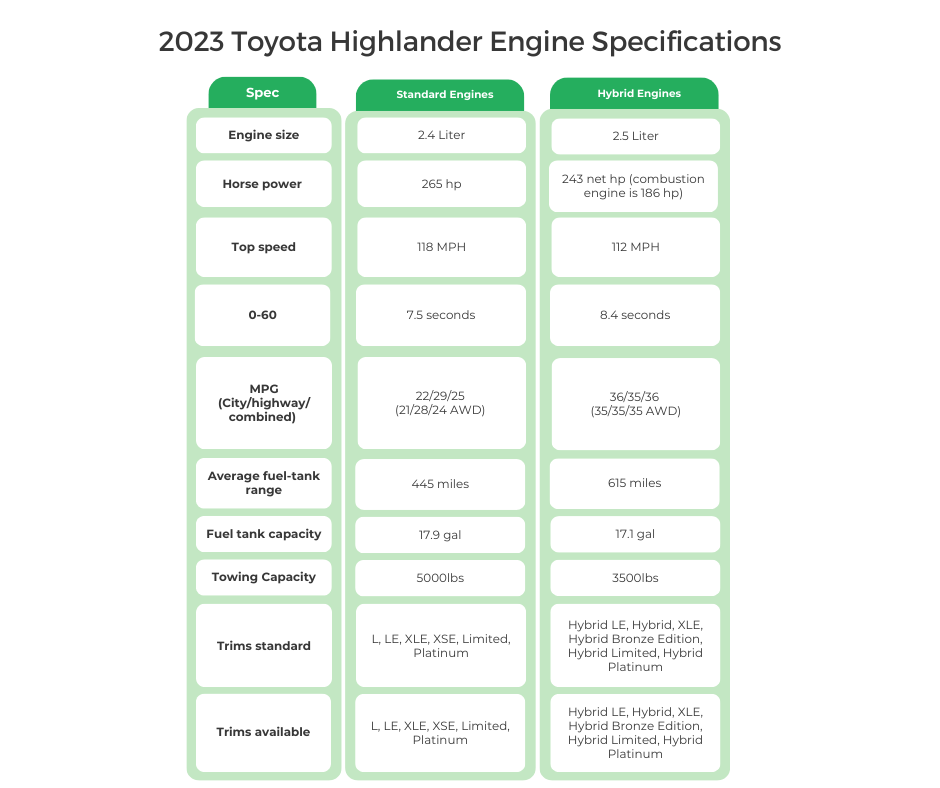
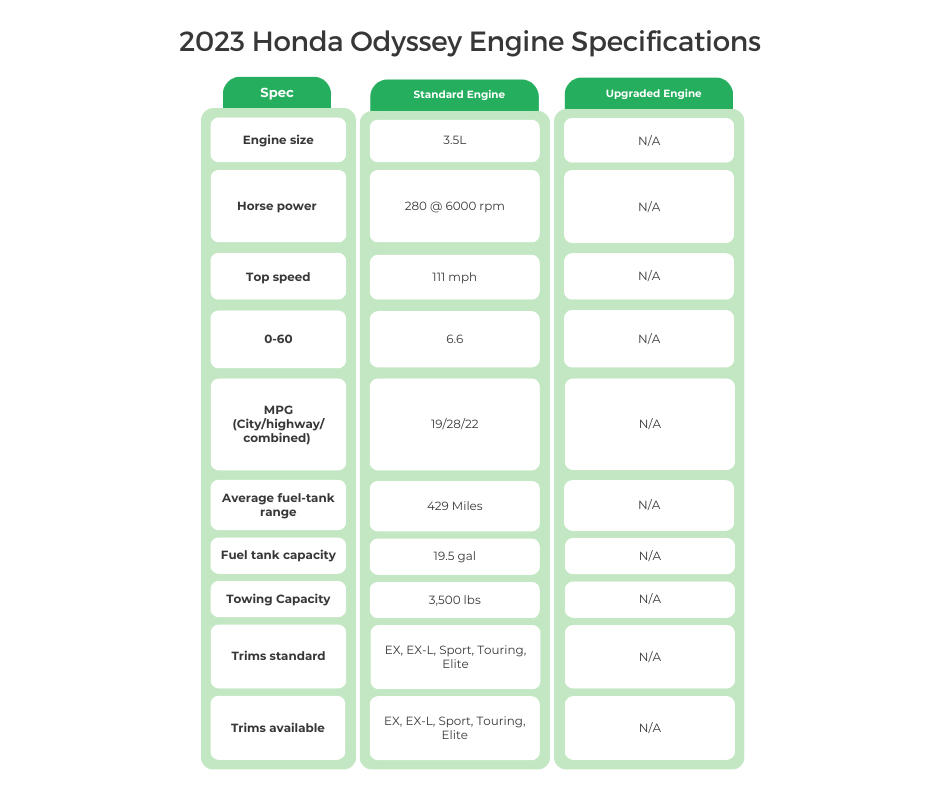
Fuel Economy:
Comparing the fuel economy of the standard HIghlander (22 city / 29 highway) against the Odyssey (19 city / 28 highway) gives the Toyota a slight edge, especially in city driving. The difference in highway fuel economy is negligible. It’s tough to make a strong case for a more expensive Highlander because fuel economy isn’t that much better.
Yet, this assumption completely changes when looking at the Highlander Hybrid. Fuel economy of 35-36 mpg is remarkable for a vehicle of this size. Someone driving 15,000 city miles annually and paying $3.50 per gallon of gasoline can reduce refueling costs by over $1,300 yearly by choosing the Highlander Hybrid over the Odyssey. This difference is enough to almost pay for the $1,600 hybrid upgrade after the first year of ownership.
Wondering about fuel economy for an older Highlander or Odyssey? Check out: Toyota Highlander Vs. Honda Odyssey | The Best Model Year For Every Budget.
Towing:
Towing may not be a priority for a Highlander or Odyssey shopper, but the ability to pull watercraft or a modest travel trailer can be a bonus. The Highlander Hybrid and Odyssey have a 3,500-pound towing limit, while the regular Highlander has a trailering capacity of up to 5,000 pounds.
Transmission Options & Specifications:
Regarding transmissions, Toyota takes old-school and new-school approaches. The standard engine is paired with a tried-and-true eight-speed automatic. It’s not the most sophisticated gearbox (which isn’t bad), but it does a nice job of balancing the demands of performance and economy.
Because fuel economy is the name of the game with the Highlander Hybrid, Toyota uses a continuously variable transmission (CVT), which favors efficiency over power delivery. The electronic CVT (eCVT) further enhances fuel economy. See the “Tech Talk” section below the charts to learn about CVTs and eCVTs.
Although Honda is big on CVTs in its new passenger cars and smaller crossovers (like the Civic, Accord, and CR-V), it sticks with a conventional automatic transmission in the Odyssey. However, this is no ordinary gearbox. It’s a sophisticated ten-speed unit substantially contributing to the Odyssey’s quick-acceleration abilities.
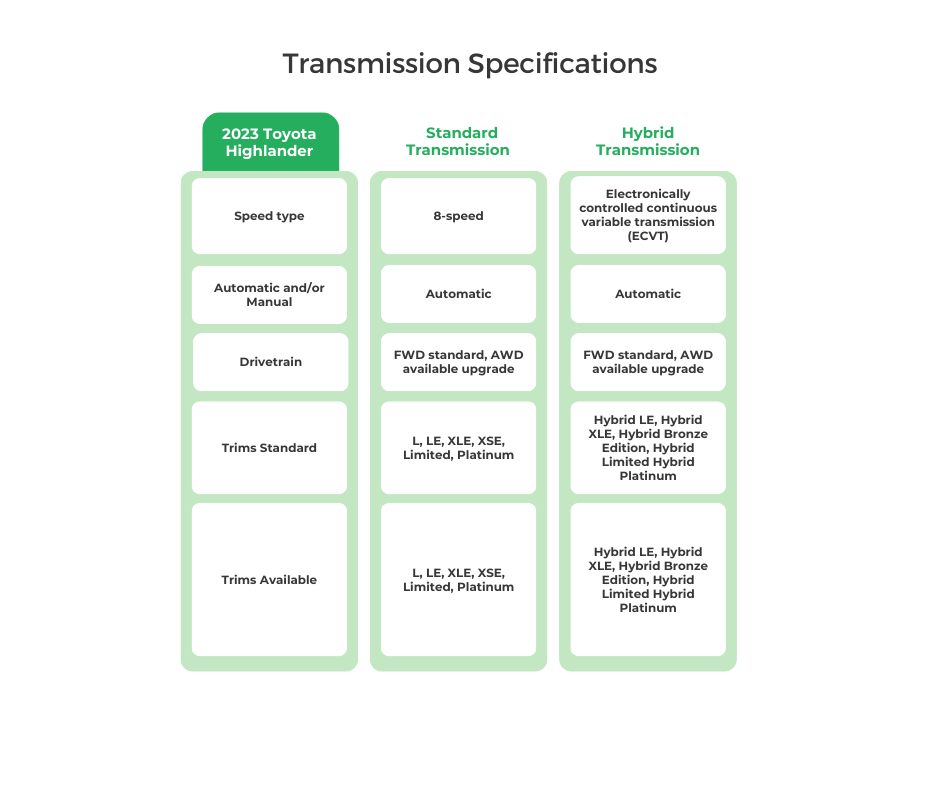
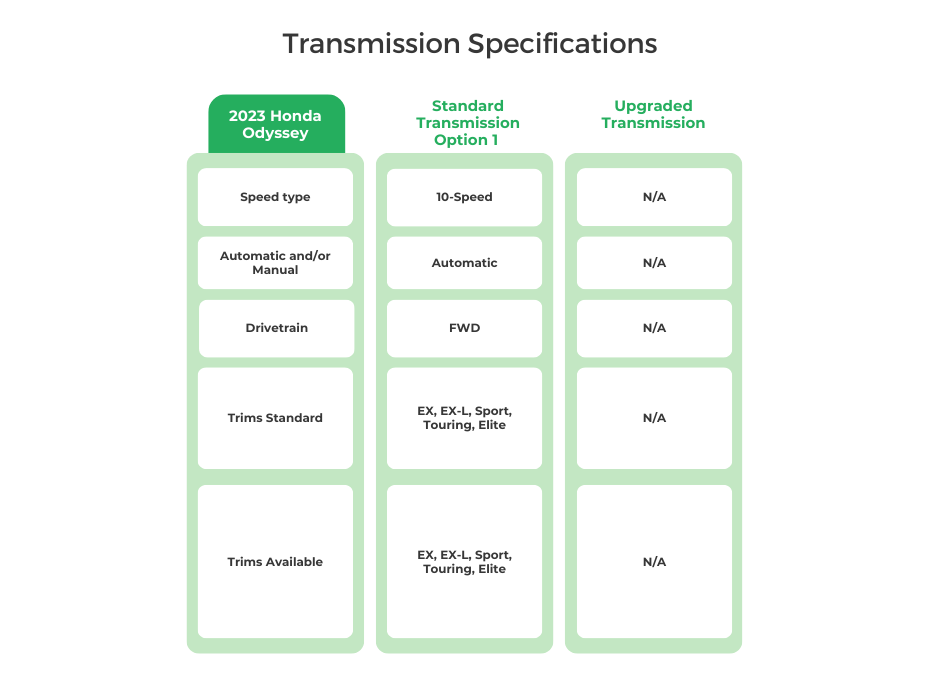
TECH TALK: CVTs
A continuously variable transmission (CVT) does not use gears like a typical automatic transmission. Instead, it has two pulleys connected by a belt. One pulley connects to the engine, and the other connects to the wheels. The belt transfers the power between the pulleys. This setup allows the pulleys to continuously change positions as needed. The CVT automatically adjusts the pulleys as required, providing smooth and efficient power delivery.
An electronic continuously variable transmission (eCVT) uses electronic controls and electric motors to vary gear ratios instead of a belt and pulley system. Unlike a regular CVT, an eCVT has no physical pulleys or belts—the gear ratio is adjusted seamlessly by controlling the speeds of electric motors and generators. This electronic control allows faster, smoother gear ratio changes compared to a traditional CVT. An eCVT also provides more flexibility, needing less space and having fewer moving parts.
Drivetrain:
Highlander drivetrain options are straightforward: standard front-wheel drive (FWD) or optional all-wheel drive. FWD should meet most needs at a lower cost for many shoppers in warmer climates or those who don’t see much snow.
That’s Honda’s thinking with the Odyssey; FWD should be good enough for most buyers. There is no option to spin all four wheels. If someone wants an AWD minivan, they’ll need to check out a Toyota Sienna or Chrysler Pacifica.
| 2023 Toyota Highlander Wheel Drive | FWD | AWD | RWD |
| L | S | U | |
| LE | S | U | |
| XLE | S | U | |
| XSE | S | U | |
| Limited | S | U | |
| Platinum | S | U | |
| Hybrid LE | S | U | |
| Hybrid XLE | S | U | |
| Hybrid Bronze Edition | S | U | |
| Hybrid Limited | S | U | |
| Hybrid Platinum | S | U |
U = Available in upgrade
| 2023 Honda Odyssey Wheel Drive | FWD | AWD | RWD |
| EX | S | ||
| EX-L | S | ||
| Sport | S | ||
| Touring | S | ||
| Elite | S |
U = Available in upgrade
Safety:
Quick Take: The Highlander and Odyssey do well in NHTSA assessments, but the Honda scores better in side crash tests. Both vehicles get top honors from IIHS.
NHTSA Safety Ratings
Excellent safety scores are mandatory to successfully sell a family vehicle in the U.S. Anyone transporting children and other loved ones wants to know their precious cargo is protected. Looking at overall safety performance in testing by the National Highway Traffic Safety Administration (NHTSA), the Highlander and Odyssey received a perfect five-star grade. The score was the same in side crash assessments.
However, the Odyssey does better (five stars) in NHTSA’s front crash test than the Highlander (four stars). The Toyota’s score isn’t terrible by any means, but it still ranks behind the Honda. I wouldn’t use this as a reason to avoid a Highlander, but those demanding flawless safety performance will have to consider these results.
A four-star rollover rating is common among taller vehicles like crossovers and minivans.
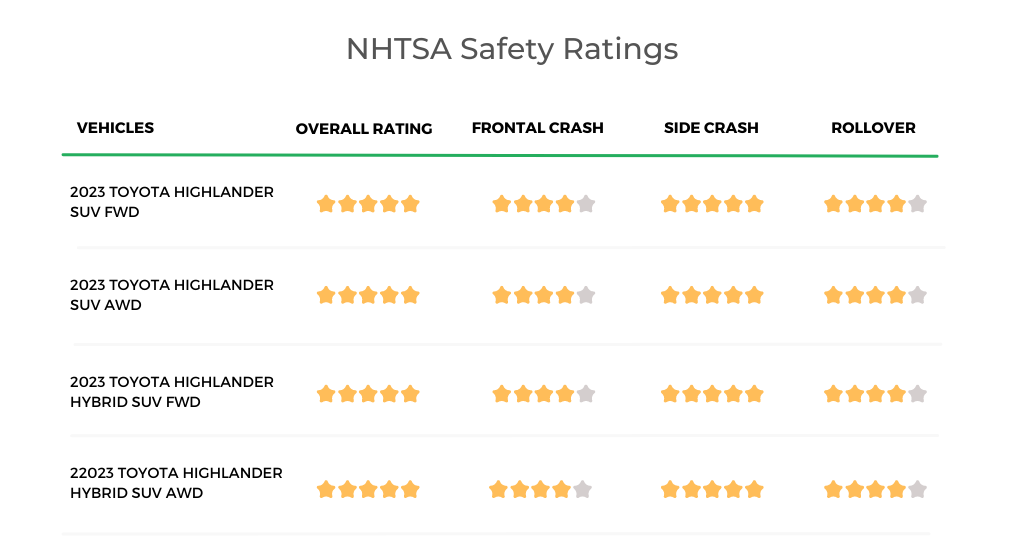

IIHS Awards:
The Insurance Institute for Highway Safety (IIHS) takes a somewhat different approach to safety testing. In particular, it focuses on its small frontal overlap crash test, which the organization feels represents a more real-world scenario (a single car running into a fixed object). IIHS also looks at side impact crashes, roof strength, headlight effectiveness, and advanced driver safety technologies (like automatic emergency braking).
While tested vehicles receive a Good, Acceptable, Marginal, or Poor grade, the true measure comes if a car gets a Top Safety Pick or Top Safety Pick+ designation. If “Good” is a “B” grade, Top Safety Pick notches things up to an “A-,” and the Top Safety Pick+ signifies an “A+.”
The Highlander and Odyssey get top praise from IIHS.
| IIHS Award | Tested Vehicle | ||
| 2023 Toyota Highlander | Midsize SUV/4-Door SUV | 2023 TOP SAFETY PICK + | 2020 Toyota Highlander LE 4-door AWD |
| 2023 Honda Odyssey | MINIVAN | 2023 TOP SAFETY PICK + | 2018 Honda Odyssey LX, EX-L, and Touring |
| 2021 Honda Odyssey Elite | |||
Airbags & Head Restraints:
Continuing a safety-focused theme, the Highlander and Odyssey have a full complement of airbags. There are units to protect the front row and side systems to safeguard the back rows in a collision or rollover. The one difference is knee airbags, which help position front-row occupants to minimize injuries. The Highlander has this only for the driver, while the Odyssey also has a knee airbag for the front passenger.
Neither the Highlander nor the Odyssey comes with overhead airbags. This newer technology replaces traditional front-row units (steering wheel and dashboard) with overhead devices. Active head restraints are usually found in specialty and high-end vehicles to minimize whiplash injuries. Mainstream cars like the Highlander and Odyssey aren’t usually equipped with this feature.
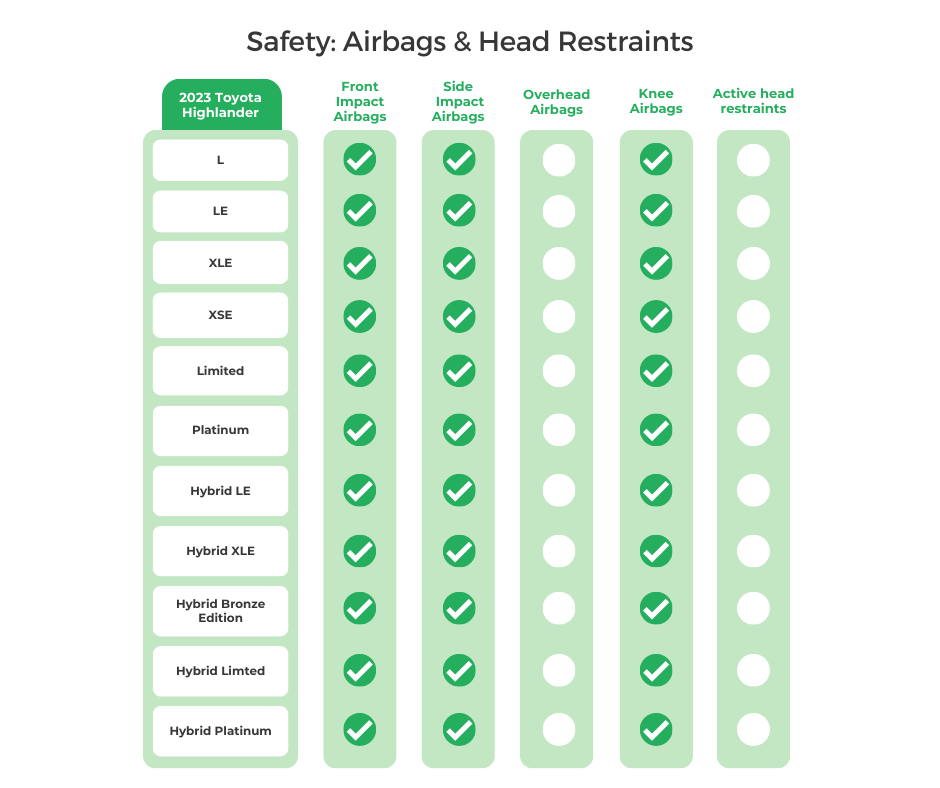
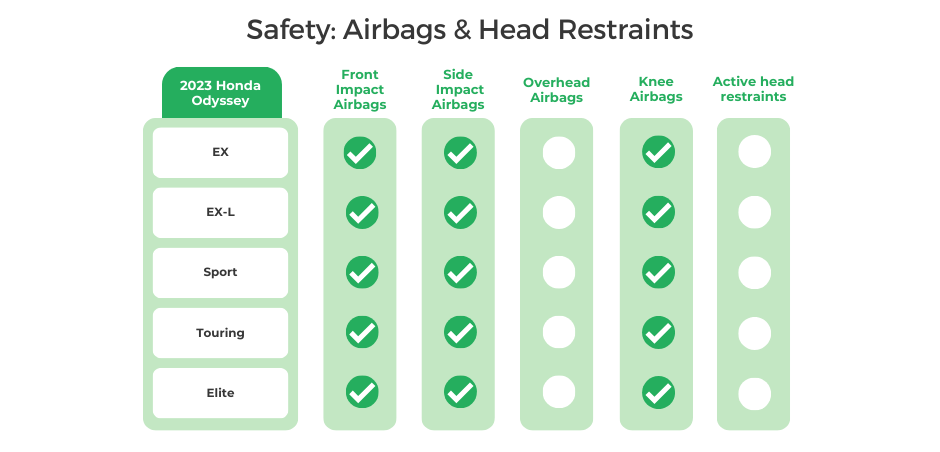
Driver-Focused Features and Equipment:
Quick Take: The Highlander and Odyssey have similar driver-assist features, but the base Highlander lacks some essentials like blind-spot monitoring.
Semi-Autonomous Driving:
Toyota and Honda leave high-tech features like hands-free driving to other automakers. The Highlander and Odyssey aren’t on the market to impress with technological wizardry but to do the job without fanfare. Nonetheless, there are still some technologies that can make driving easier and safer.
One feature, adaptive cruise control (Toyota calls it Dynamic Radar Cruise Control), automatically adjusts the vehicle’s speed to maintain a set distance between it and the car in front. It’s standard on all Highlander and Odyssey trims. Both vehicles also get lane-keeping systems that make subtle steering corrections to keep a car in its lane.
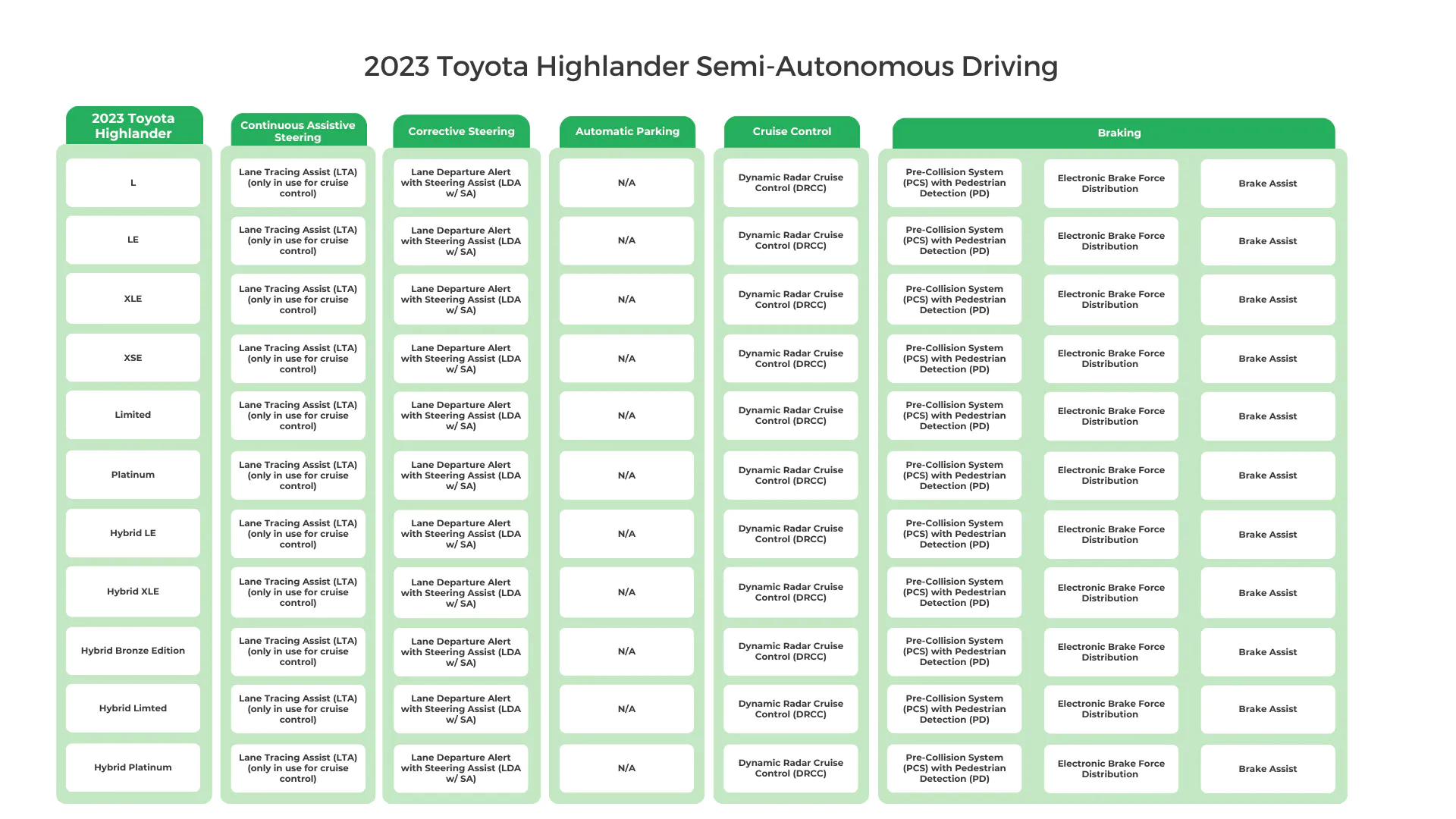
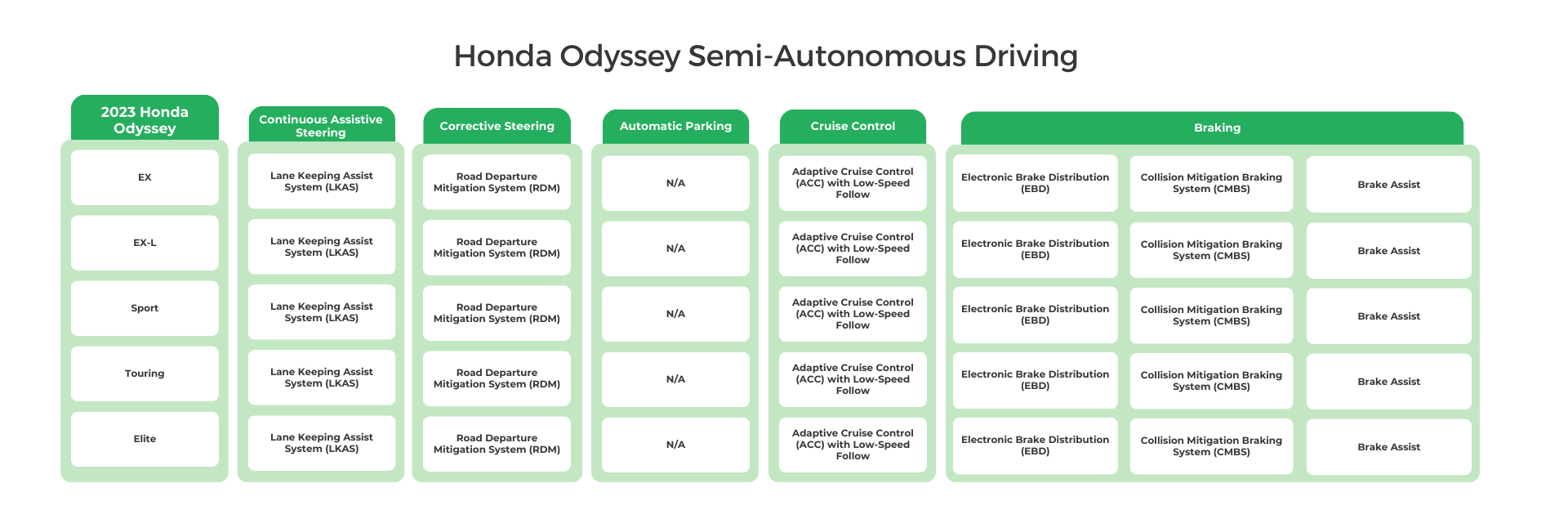
Driver Warning Systems & Telematics:
All 2023 Highlander and Odyssey editions come with advanced driver assistance systems (ADAS) like forward collision warning (FCW) and automatic emergency braking (AEB). It’s a technology that’s included with most new cars. Other vital features—blind-spot monitoring (BSM) and rear cross-traffic alert (RCTA)—are standard with all Highlanders and Odysseys except the base Highlander L. It’s not even an upgrade. Keep this in mind because BSM and RCTA can be lifesavers.
Otherwise, both vehicles get a rear seat reminder so no one gets left behind. There’s also tech to signal the driver if the car appears to wander outside its lane (lane departure alert or warning).
Roadside sign assist isn’t the most essential ADAS feature, but it can be a handy reminder of speed limits and other vital information. Only the Highlander Platinum trims (non-hybrid and hybrid) have this system, while it’s standard on all Odysseys.
If ADAS technology appears like alphabet soup, check out an effort from AAA, Consumer Reports, J.D. Power, and other groups working to standardize the terminology for these systems.
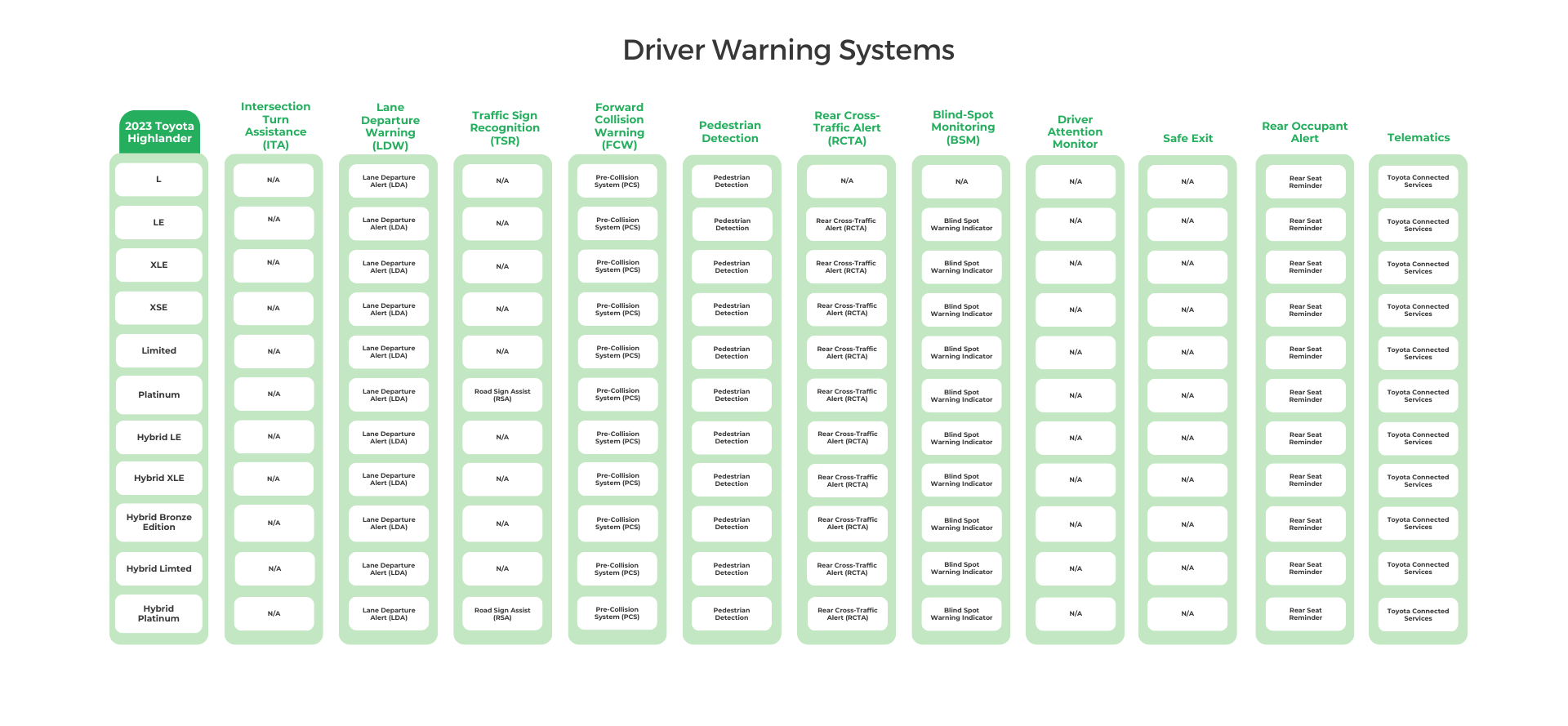

Road Visibility Features:
While Toyota may have skimped on a few ADAS essentials, even the base Highlander gets LED headlights. So do all Odyssey trims. The same applies to automatic high beams and a rearview monitor.
Yet there’s some separation with more premium visibility features. Rain-sensing windshield wipers are reserved for high-end editions (Highlander Platinum and Odyssey Elite). The Highlander Platinum only gets a head-up display (key driver information is projected onto the windshield) and adaptive headlights (the beams aim in sync with steering wheel movements).
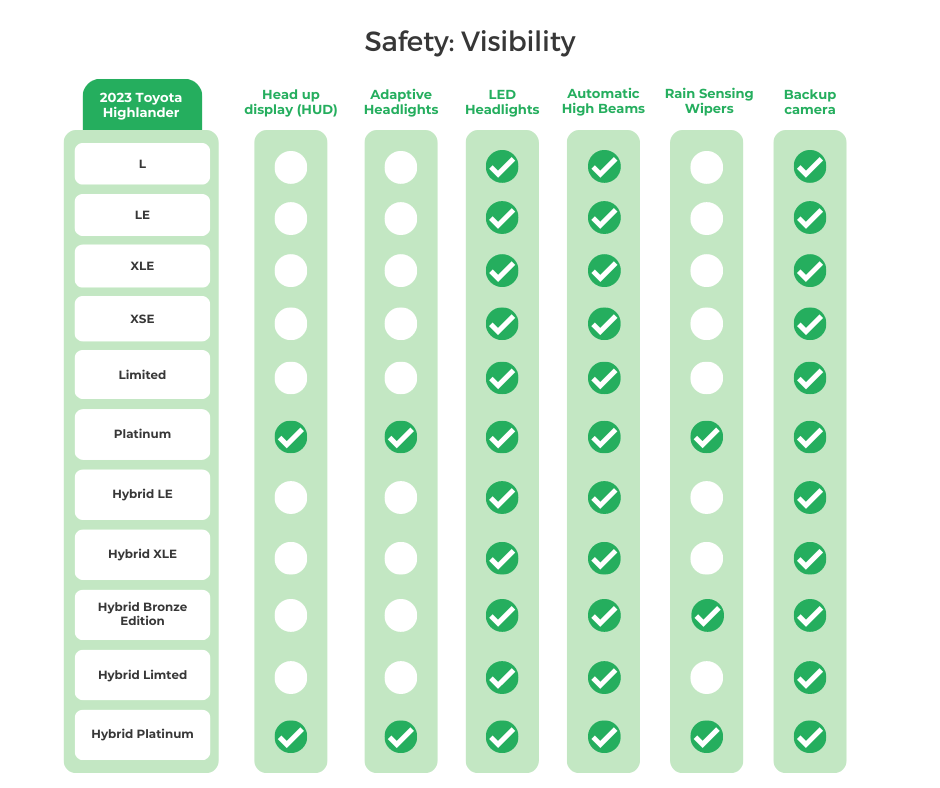
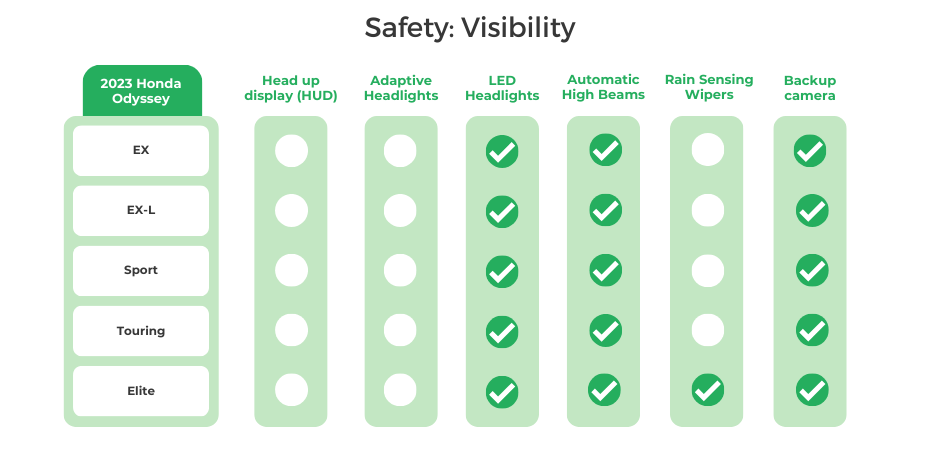
Interior:
Quick Take: The Highlander and Odyssey overall have similar interior features, but the Odyssey’s greater cabin size translates into a cavernous cargo capacity.
Interior Features:
Regardless of which Highlander or Odyssey edition gets purchased, all are equipped with Apple CarPlay and Android Auto, a comfort to phone-dependent buyers.
There’s no worry for those with heated front seats on their must-have list. All 2023 Highlanders and Odysseys are equipped with this toasty feature.
And speaking of heated seats, some automakers offer this feature through a subscription service. This hasn’t yet happened in the U.S., but in certain countries, BMW offered heated seats for a monthly fee. The advantage is you can shut off the service during warm months, but you’ll need to keep paying (or pay a one-time upfront fee) to activate the heated seats. Recently, BMW announced it was backing away from this practice. Moving forward, the automaker will only charge a subscription for software-based services (like upgraded navigation). Hardware-based features will be part of the vehicle’s initial purchase price.
One industry study shows mixed results for consumer acceptance of features on demand (FoD), with about one-fifth not even being aware of the concept.


Interior Dimensions:
Although the Odyssey has a larger overall interior, this extra space doesn’t always mean this Honda excels in key cabin measurements. Most notably, 40.9 inches of front legroom lags behind the 42 inches in the Highlander.
However, the Odyssey comes out ahead in most other dimensions. Not only does the Odyssey have a more spacious second row (40.9 inches of legroom versus 39.0 inches), but its third row is truly exceptional. The Odyssey has a very generous 38.1 inches of third-row legroom compared to a tight-squeeze 28.0 inches for the Highlander. Passengers will also notice substantially more hip and shoulder room in all three rows of the Odyssey.
Yet, the Odyssey’s space advantage comes to light when looking at the cargo room. Behind the third row, the Honda can hold up to 32.8 cubic feet of stuff, while the Highlander’s capacity is half that (16.0 cubic feet). It’s a similar situation behind the second row: 89.2 cubic feet for the Odyssey against 48.4 cubic feet for the Highlander.
The Odyssey further flexes its cargo capacity muscles with a massive 144.9 cubic feet when the second and third rows are folded. The Highlander only offers 84.3 cubic feet behind the first row.
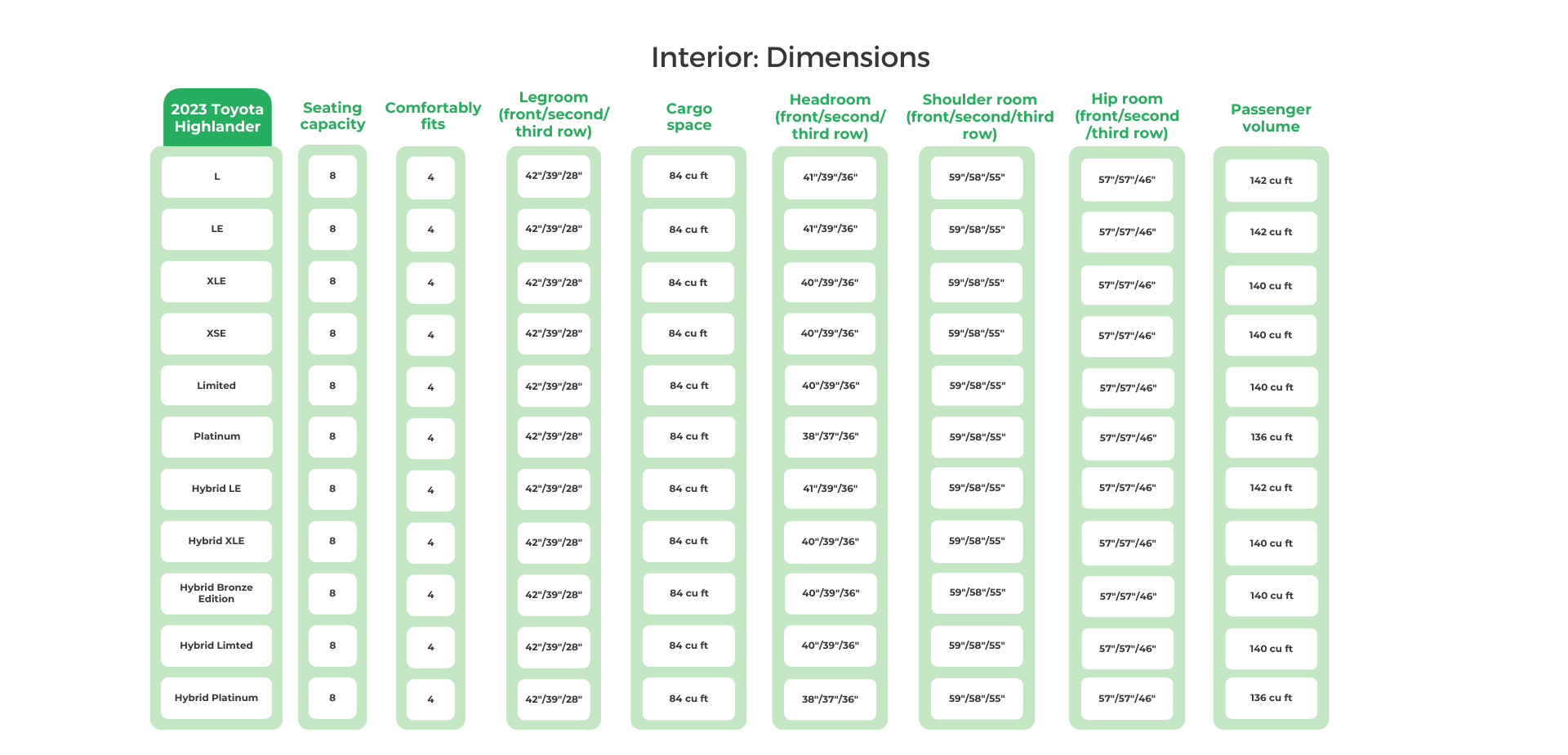

Exterior:
Quick Take: The color choices for the Highlander and Odyssey are primarily monochromatic, with a splash of blue or red. The Odyssey’s larger interior means a larger exterior.
Exterior Features:
Wheels may also be an afterthought for many car buyers. But wheel size can impact ride quality. Larger rims can translate into better traction and cornering but may result in a bumpier ride. Bigger wheels also offer better aesthetics by filling out the wheel wells more completely. This is why the higher the trim, the larger the wheel. Different materials (steel or alloy) and finishes also help separate the wheels among the various trim levels.
Don’t look at Toyota or Honda for making a Highlander or Odyssey in multiple bright colors. Family cars are all about blending in, not standing out. The truth is that 79% of all vehicles sold in 2023 are white, black, gray, or silver, collectively called grayscale shades. The data comes from a recent iSeeCars.com study, which also shows that blue accounts for 9.7% of sales and red adds up to 8.2% of business.
These automakers are just responding to market demands. That said, the Highlander and Odyssey are available in a muted blue and almost bright red. Toyota also offers Cypress Green.
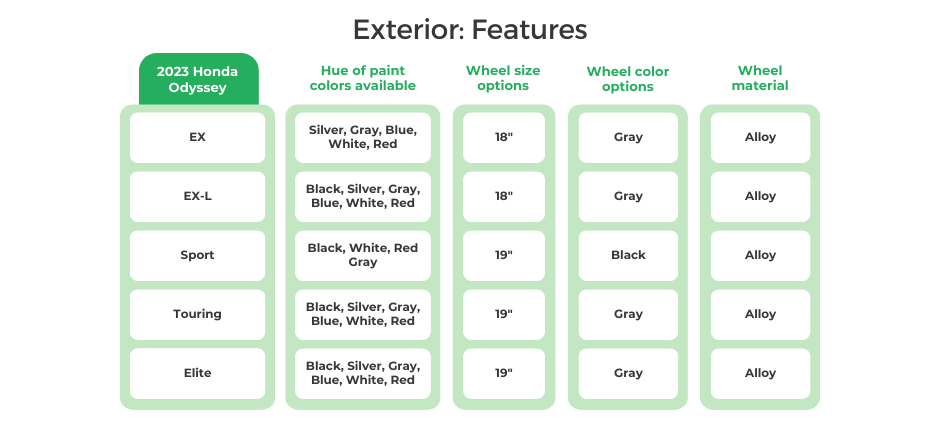
Exterior Dimensions:
Neither vehicle is small, but the Odyssey’s 205.2-inch length makes this Honda that much more challenging than the 195-inch long Highlander. The Odyssey’s extra 2.5 inches of width doesn’t help matters, either. Of course, none of this will matter in wide-open spaces or ample garages at home. But urban settings could make for a tight squeeze with Honda’s minivan.
There are pros and cons to consider with ground clearance. The Highlander’s eight inches between the ground and the chassis makes for easier travel over speed bumps and rough terrain but can make entry and exit tougher, especially for children. It’s just the opposite with the Odyssey’s 4.5-inch ground clearance. Getting in and out is a breeze, but don’t be surprised when the vehicle bottoms out over a speed bump.
Lastly, the Odyssey has a greater wheelbase (118.1 inches versus 112.0 inches) in its favor. The extra space between axles helps smooth uneven roads and lessens the impact of highway expansion strips.

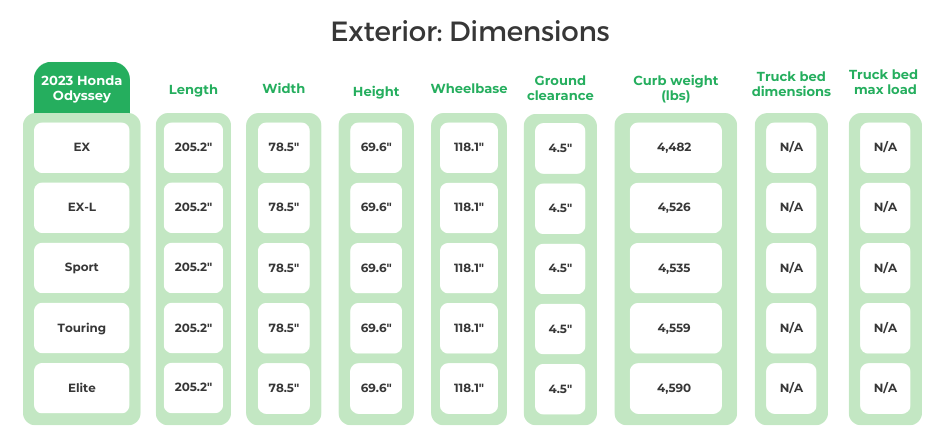
Warranty:
Quick Take: The Highlander and Odyssey have near-identical warranty coverage.
Choosing between a Highlander and an Odyssey isn’t likely to come down to the factory warranty; Toyota and Honda offer almost the same coverage. Buyers get three years, or 36,000 miles, of bumper-to-bumper protection and a powertrain warranty for five years, or 60,000 miles.
Toyota and Honda also include two years of free scheduled maintenance with a 25,000-mile cap for the Highlander and a 24,000-mile limit for the Odyssey. This modest distinction and Honda offering three years of roadside assistance (versus two years for Toyota) are the contrasts in warranty protection.
| 2023 Toyota Highlander Factory Warranty Coverage: | 2023 Honda Odyssey Factory Warranty Coverage: | |
| Basic warranty: | 36 Months/36,000 Miles | 36 months/36,000 miles |
| Powertrain warranty: | 60 Months/60,000 Miles | 60 months/60,000 miles |
| Corrosion perforation warranty: | 60 Months | 60 months/unlimited miles |
| Air conditioning warranty: | 12 Months/12,000 Miles | 24 months/24,000 miles |
| Battery warranty: | 120 months/150,000 miles (Hybrid Battery) | 36 months/36,000 miles |
| Emissions warranty: | Federal: 36 month/36,000 miles (defect), 24 months/24,000 miles (performance)California: 36 months/50,000 miles (performance) | Federal: 36 months/36,000 miles California: 36 months/50,000 miles |
| Complimentary scheduled maintenance: | 24 months/25,000 miles | 24 months/24,000 miles |
| Roadside assistance coverage: | 24 months/25,000 miles | 36 months/36,000 miles |
| Total unique recalls: | 1 (related to driver’s airbag, NHTSA Campaign number: 23V480000) | 1 |
Methodology
- Compare two vehicles, the Toyota Highlander and the Honda Odyssey and provide a comprehensive analysis.
- Gather relevant information and data on both vehicles from reliable sources, such as manufacturer specifications, expert reviews, customer feedback, industry reports, and data sources like manufacturer websites, FIXD App, Kelley Blue Book, FuelEconomy.gov, and NHTSA.
- Collect data on various aspects, including performance, safety features, fuel efficiency, maintenance costs, reliability, owner satisfaction, and market value.
- Identify the key criteria that will be used to evaluate and compare the two vehicles.
- Ensure the criteria cover both objective factors (such as performance metrics, safety ratings, and fuel efficiency) and subjective factors (such as owner satisfaction, comfort, and features).
- Assess the performance of both vehicles based on factors such as acceleration, handling, braking, and overall driving experience.
- Compare engine options, horsepower, torque, transmission options, and any unique performance features.
- Examine the safety features and ratings of both vehicles.
- Evaluate crash test ratings, advanced driver assistance systems (ADAS), active and passive safety features, and any notable recalls or known issues related to safety.
- Consider both NHTSA safety ratings and IIHS awards for a comprehensive safety assessment.
- Analyze the fuel economy of both vehicles based on EPA mileage estimates.
- Compare their MPG ratings, average full-tank range, and any significant differences in fuel efficiency.
- Assess the average annual maintenance and repair costs for both vehicles.
- Consider data from surveyed owners and other reliable sources, such as FIXD App owner surveys, to determine the overall cost of ownership over time.
- Evaluate the reliability of both vehicles based on owner reports, FIXD App data, and any known issues or recalls.
- Consider factors such as engine reliability, common problems by model year, long-term durability, and owner reliability scores gathered from surveys.
- Consider owner satisfaction by gathering information from forums, online communities (Reddit: r/whatcarshouldIbuy), customer reviews, and owner reliability scores.
- Summarize key factors that owners appreciate and any common complaints or drawbacks mentioned by owners.
- Compare the features and technologies offered by both vehicles.
- Highlight any notable differences in terms of infotainment systems, connectivity options, driver assistance features, interior quality, and available upgrades.
- Assess the market value and depreciation of both vehicles.
- Compare average prices, resale value, and how the vehicles hold their value over time.
- Consider average private-seller valuations from Kelley Blue Book (KBB) for a comprehensive assessment.
- Summarize the findings of the comparison, highlighting the positives and negatives of each vehicle.
- Provide a fair and balanced recommendation based on the comparison, considering factors such as budget, personal preferences, specific needs of the buyer, and the comprehensive analysis conducted.
Sources:
- Fuel Economy: Mileage-per-gallon estimates according to the EPA MPG on Fueleconomy.gov.
- Safety Ratings: Crash test data collected and reported by NHTSA, as well as IIHS Award information, were collected for this article.
- Vehicle Prices/Features: Most or all information gathered on vehicle features was from the manufacturer’s website, in this case, toyota.com and hondacars.com.

Dave Goldberg is an automotive journalist and lifelong car fanatic. He writes for numerous enthusiast and business outlets and is an ongoing contributor to HotCars.com, one of the most popular car culture websites. When he’s not writing or driving, Dave is either under a hood or asleep. His credentials include a BA in Journalism from The George Washington University.

